
Quercus lusitanica
Encyclopedia
Quercus lusitanica, commonly known as Gall Oak, Lusitanian Oak, or Dyer's Oak, is a species of oak native to Morocco
, Portugal
, and Spain
. Q. lusitanica is the source of commercial nutgalls. These galls are produced by the infection from the insect Cynips gallae tinctoriae. They are used for dyeing
.
Other names for the galls are Turkish gall, Galla tinctoria, Galla halepense, Galla levantica or Galla quercina, manjakani
in Asia Minor or majuphal in India. In Tamil it is called 'maasikkaay' and is used by Tamils for more than 2000 years. Every home will a have one or two pieces as it is quite useful for children.
Morocco
Morocco , officially the Kingdom of Morocco , is a country located in North Africa. It has a population of more than 32 million and an area of 710,850 km², and also primarily administers the disputed region of the Western Sahara...
, Portugal
Portugal
Portugal , officially the Portuguese Republic is a country situated in southwestern Europe on the Iberian Peninsula. Portugal is the westernmost country of Europe, and is bordered by the Atlantic Ocean to the West and South and by Spain to the North and East. The Atlantic archipelagos of the...
, and Spain
Spain
Spain , officially the Kingdom of Spain languages]] under the European Charter for Regional or Minority Languages. In each of these, Spain's official name is as follows:;;;;;;), is a country and member state of the European Union located in southwestern Europe on the Iberian Peninsula...
. Q. lusitanica is the source of commercial nutgalls. These galls are produced by the infection from the insect Cynips gallae tinctoriae. They are used for dyeing
Dyeing
Dyeing is the process of adding color to textile products like fibers, yarns, and fabrics. Dyeing is normally done in a special solution containing dyes and particular chemical material. After dyeing, dye molecules have uncut Chemical bond with fiber molecules. The temperature and time controlling...
.
Other names for the galls are Turkish gall, Galla tinctoria, Galla halepense, Galla levantica or Galla quercina, manjakani
Manjakani
Manjakani or "Oak galls" comes from oak trees indigenous to Asia Minor and Persia. They are produced when the leaves of the oak tree are penetrated by stinging wasps...
in Asia Minor or majuphal in India. In Tamil it is called 'maasikkaay' and is used by Tamils for more than 2000 years. Every home will a have one or two pieces as it is quite useful for children.

